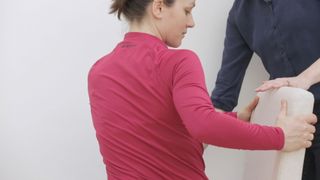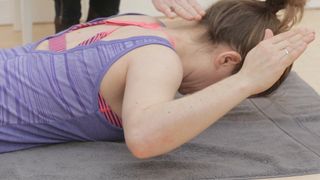5 Stretches And Exercises That Will Feel Amazing After A Day At The Office
Chartered physiotherapist Lucy Macdonald recommends ways to combat the effects of a day hunched over at a desk
If you’re reading this on your desktop or mobile and you’re not hunching your shoulders or craning your neck, well done, but there’s probably little point in you sticking around. Go marvel at these mad diets from history.
Now we’ve got rid of that one smug person in a million, let’s do something about the stiffness, tension and soreness the rest of us carry after a day in the office. Even with the best will in the world it’s all too easy to slump in your chair or hunch over your keyboard when you’re tired or stressed – which is probably a decent amount of time at work.
We asked physiotherapist Lucy Macdonald to recommend moves that will bring a measure of instant relief as well as building strength and flexibility over time.
You can watch videos of each of these moves (and dozens more) on the Octopus Clinic website, where Macdonald is a director. You’ll just need to enter your email address to access them.
Just remember, all of these moves should be pain-free. If you feel any discomfort while doing them, stop, and don’t attempt them again until you’ve consulted with a physiotherapist or osteopath in person.
Release Your Back With This Chair Twist

Why “This stretch mobilises the joints, muscles of your thoracic [upper and middle] spine and rib cage, and increases circulation in these regions,” says Macdonald. “It also takes the pressure off the neck and lower back. Doing the exercise will have immediate results but the more frequently you do it, the greater and longer-lasting the effects.”
How “Sitting in an upright position on the edge of one corner of your chair, turn your body so your body and feet are facing either two or ten on the clock face. Twist your torso to reach around and grab the back of the chair on either side. Keep your feet on the floor and use your arms to pull gently yourself around a little further. Make sure it is completely pain-free. Do the same in the other direction.” Repeat ten times. Watch the video.
Get the Coach Newsletter
Sign up for workout ideas, training advice, reviews of the latest gear and more.
Relax With This Simple Breathing Technique
Why Any breathing exercise will have a calming effect, but Macdonald explains that “by drawing the air to the bottom of your lungs, this move will improve the oxygenation of your blood as more gas exchange takes place at the base of the lungs. Also, by expanding the rib cage you increase the circulation in and mobility of this region. If you find this exercise difficult then it is a sign you will probably benefit most from it, so persevere.”
How This exercise can be done standing, sitting or lying on your back. “Put your hand just above your bellybutton. Think about gently drawing the air into this area as you breathe in and then fully empty the air from this region as you breathe out. Focus on the breaths out more than the breaths in and use normal breaths, not deep breaths.” Repeat ten times. Watch this video for more breathing exercises.
Build The Shoulder Strength To Sit Straight

Why “After sitting down all day the shoulders, neck and upper back can drop forwards so this exercise – which works the extensor muscles – is a great antidote,” says Macdonald. You’ll feel beneficial effects immediately from the muscles being activated and the sensory feedback of moving these joints into a better position, but long-term strength will take weeks of doing it three to four times a week.
How “If your upper back is fixed in a slumped position you will need to see a physiotherapist to be able to do the exercise. Don’t forget it should be completely pain-free,” says Macdonald. “Lie on your belly with your chin tucked in, arms at 90° to your body and your elbows also bent at a 90° angle. Pull your shoulder blades together, lift your wrists and then your elbows, and then lift your head and upper chest while keeping your chin tucked in. Lower back to the start.” Repeat ten times. Watch the video and once that’s mastered, progress to this video.
Strengthen Your Lower Back With This Foam Roller Move
Why “You can do this exercise on the floor but it is worth investing in a 90cm foam roller for the full effect,” says Macdonald. “The exercise activates the muscles that support your lower back and pelvis, which provide the foundations for your spine. These muscles often become weak and inactive after sitting all day, especially if you have lower back pain. You can increase their activity immediately by doing this exercise, but achieving sustained strength in this area will take about six weeks, depending on how often you practise.”
How “Lie on the floor with the foam roller, if you’re using one, along your spine – your head on one end and your bottom on the other. Your knees should be bent and feet flat on the floor with your feet and knees about hip-width apart. With your hands on the floor turn your palms upwards and move your arms away from your body a little. Make sure you have a little gap under the lower back and your chin is tucked in. Breathe as described above as you lift your arms so they are hovering by your side. Contract your pelvic floor muscles and lower abdominals as you reach alternate arms above your head.” Spend five minutes or more doing this exercise. Watch this video, and subsequent ones, for more foam roller work.
Energise Your Body With Squats

Why “These are great for getting your legs and body moving after being static all day, immediately working your muscles and improving circulation, and increasing your strength in the long term,” says Macdonald.
How You’re probably familiar with the squat, but Macdonald has a vital form pointer. “Make sure you get your knee alignment right by ensuring your knees point over the centre of your feet. Also, do not let the knees drop in and ensure you maintain your lower back curve.” Repeat ten times. Watch this video and this video for more advice.
Visit octopusclinic.com for more information

Jonathan Shannon has been the editor of the Coach website since 2016, developing a wide-ranging experience of health and fitness. Jonathan took up running while editing Coach and has run a sub-40min 10K and 1hr 28min half marathon. His next ambition is to complete a marathon. He’s an advocate of cycling to work and is Coach’s e-bike reviewer, and not just because he lives up a bit of a hill. He also reviews fitness trackers and other workout gear.
